Abstract
Survival of Escherichia coli and Salmonella spp. in estuarine waters was compared over a variety of seasonal temperatures during in situ exposure in diffusion chambers. Sublethal stress was measured by both selective-versus-resuscitative enumeration procedures and an electrochemical detection method. E. coli and Salmonella spp. test suspensions, prepared to minimize sublethal injury, were exposed in a shallow tidal creek and at a site 7.1 km further downriver. Bacterial die-off and sublethal stress in filtered estuarine water were inversely related to water temperature. Salmonella spp. populations exhibited significantly less die-off and stress than did E. coli at water temperatures of less than 10 degrees C. Although the most pronounced reductions (ca. 3 log units) in test bacteria occurred during seasonally warm temperatures in the presence of the autochthonous microbiota, 10(2) to 10(4) test cells per ml remained after 2 weeks of exposure to temperatures of greater than 15 degrees C. Reductions in test bacteria were associated with increases in the densities of microflagellates and plaque-forming microorganisms. These studies demonstrated the survival potential of enteric bacteria in estuarine waters and showed that survival was a function of interacting biological and physical factors.
Full text
PDF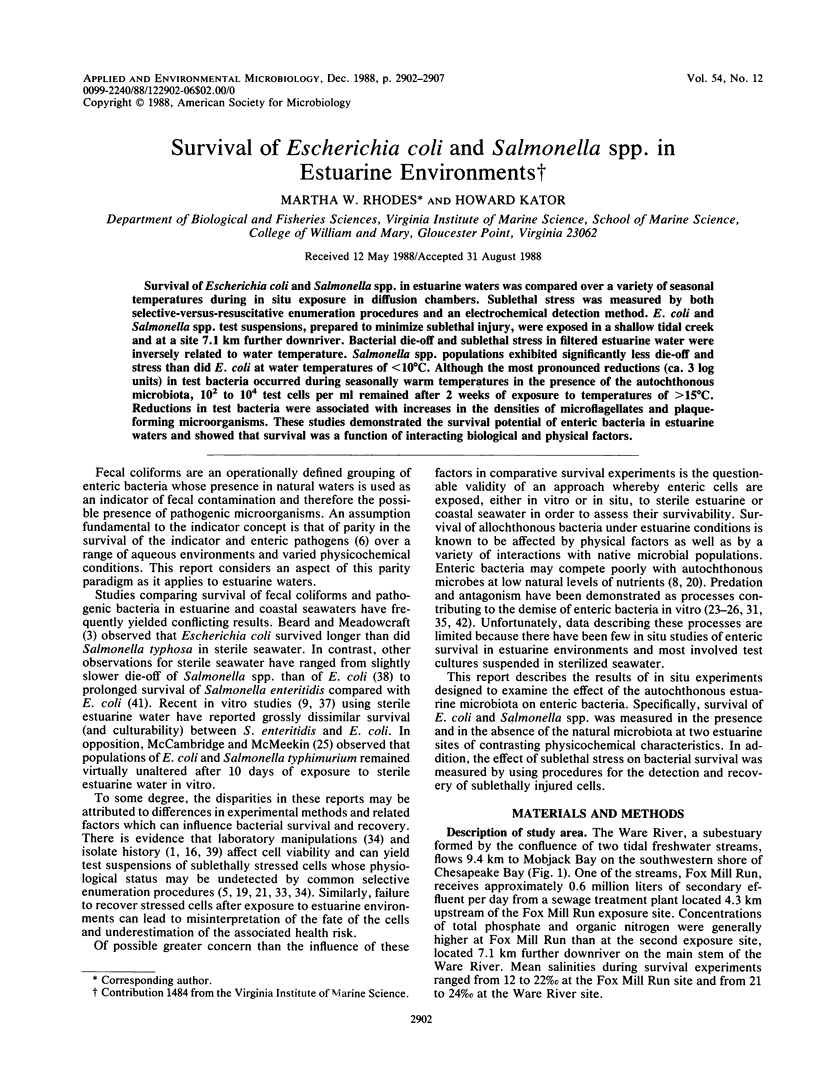
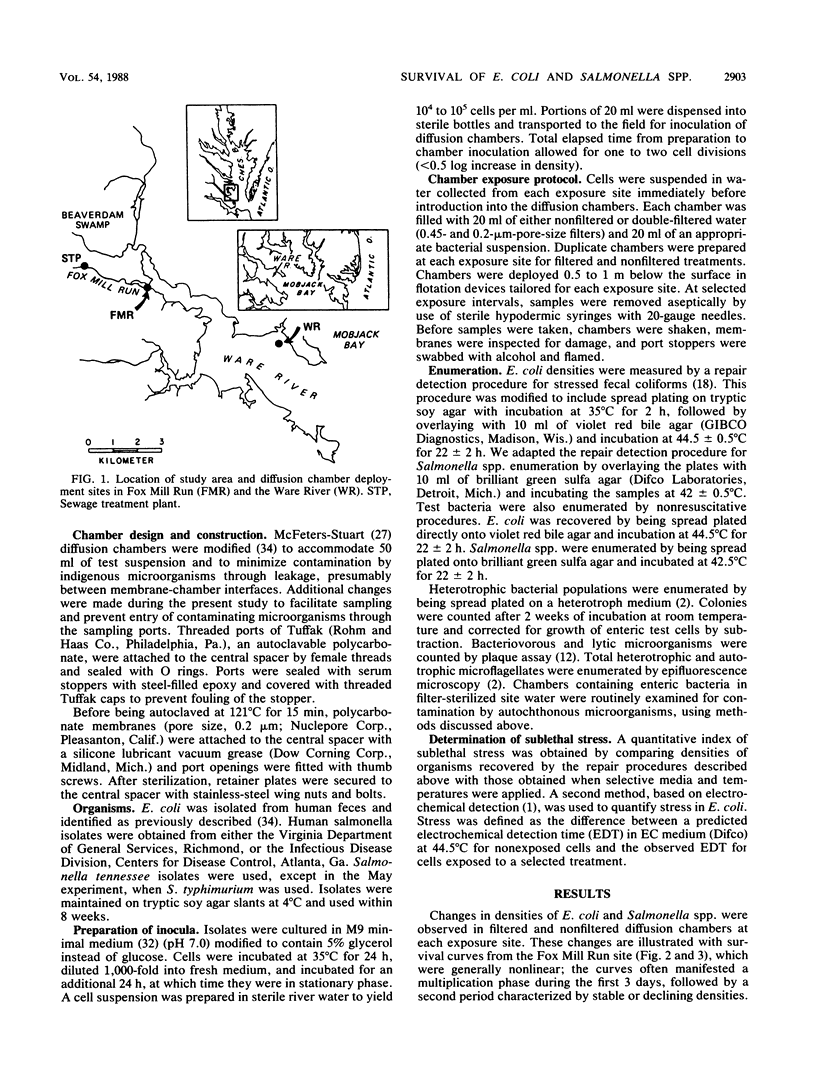
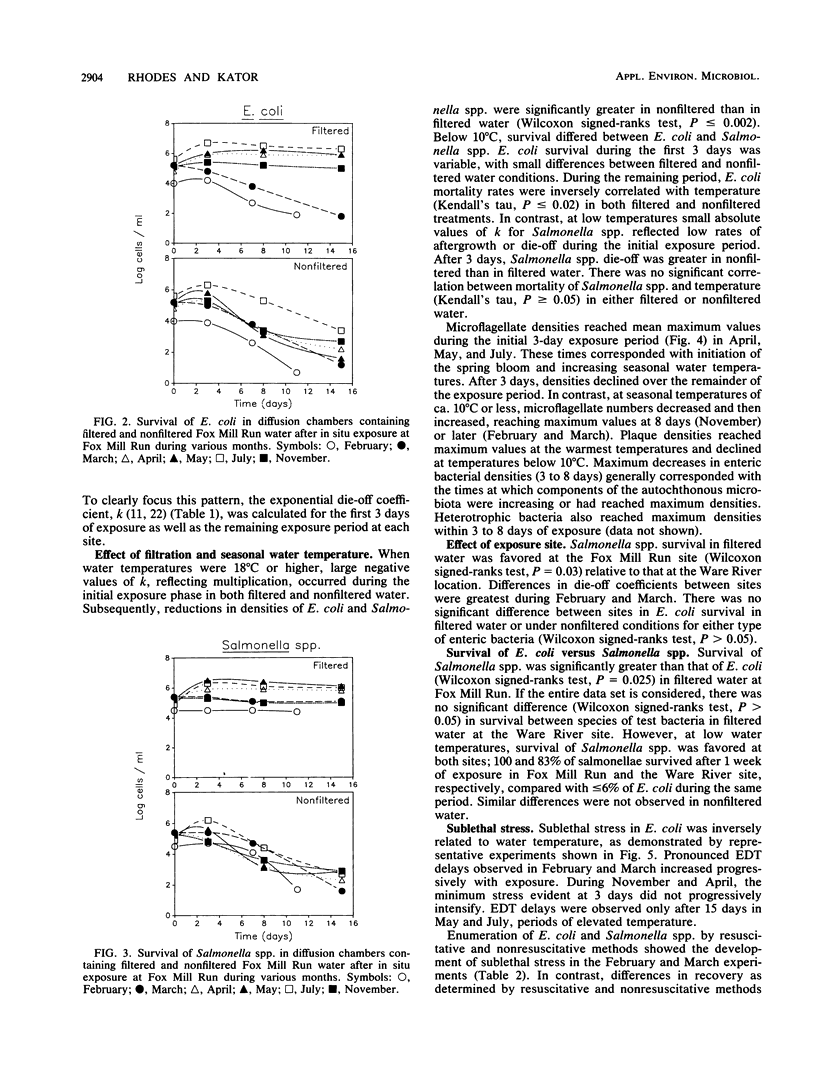
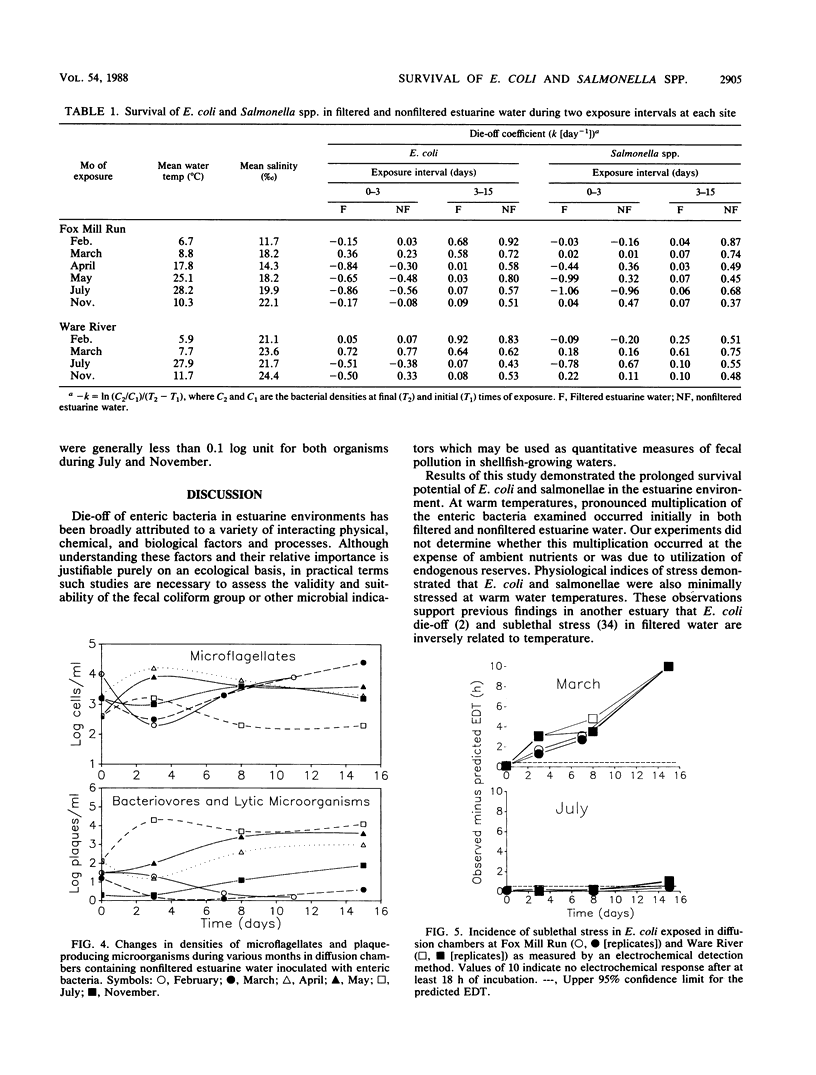
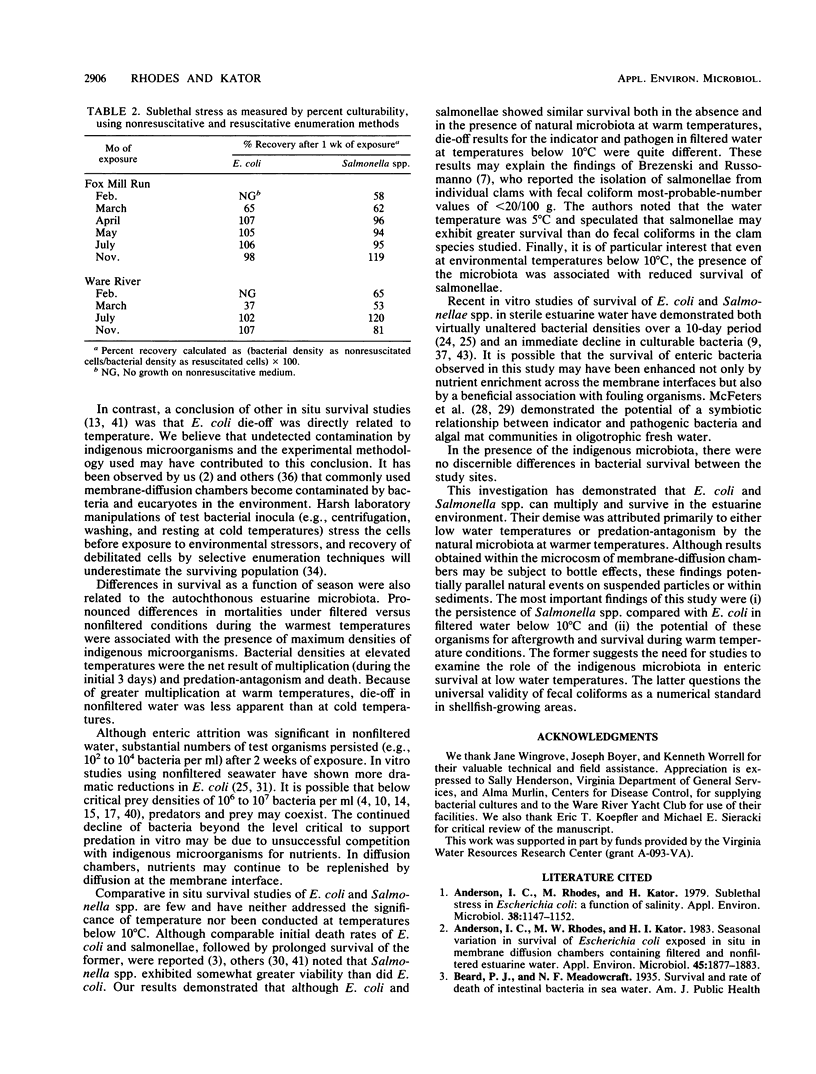
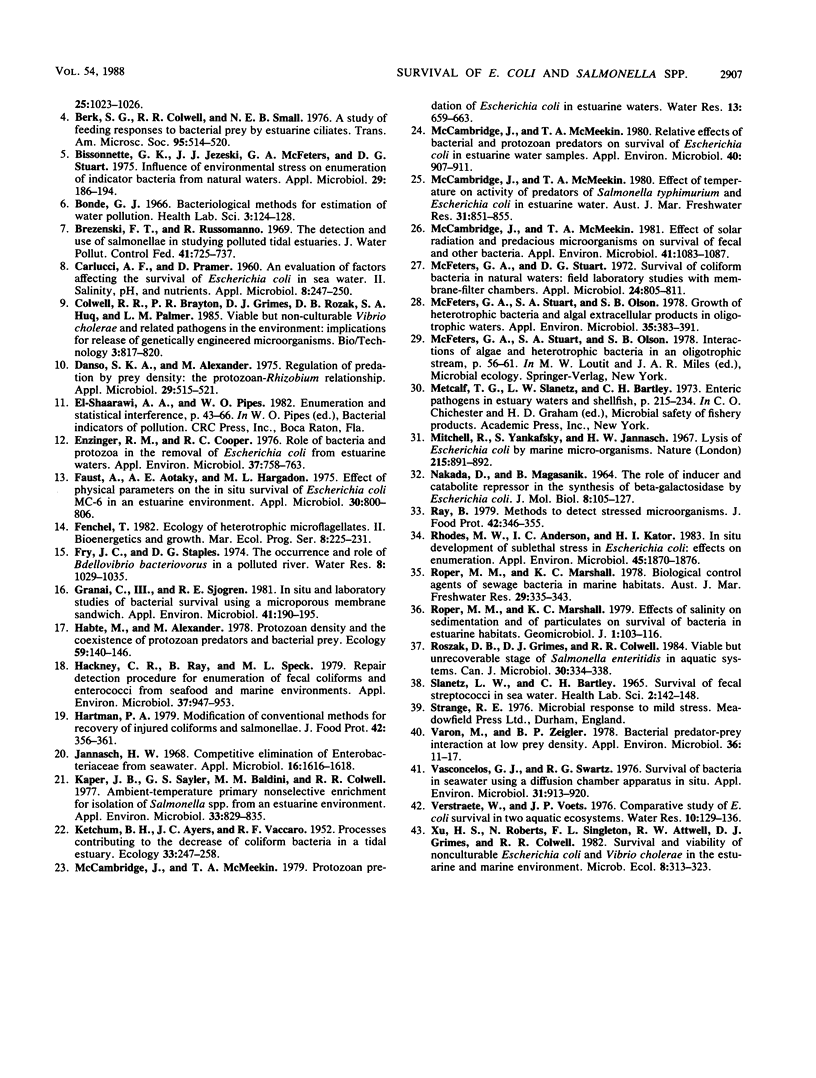
Selected References
These references are in PubMed. This may not be the complete list of references from this article.
- Anderson I. C., Rhodes M. W., Kator H. I. Seasonal variation in survival of Escherichia coli exposed in situ in membrane diffusion chambers containing filtered and nonfiltered estuarine water. Appl Environ Microbiol. 1983 Jun;45(6):1877–1883. doi: 10.1128/aem.45.6.1877-1883.1983. [DOI] [PMC free article] [PubMed] [Google Scholar]
- Anderson I. C., Rhodes M., Kator H. Sublethal stress in Escherichia coli: a function of salinity. Appl Environ Microbiol. 1979 Dec;38(6):1147–1152. doi: 10.1128/aem.38.6.1147-1152.1979. [DOI] [PMC free article] [PubMed] [Google Scholar]
- Bissonnette G. K., Jezeski J. J., McFeters G. A., Stuart D. G. Influence of environmental stress on enumeration of indicator bacteria from natural waters. Appl Microbiol. 1975 Feb;29(2):186–194. doi: 10.1128/am.29.2.186-194.1975. [DOI] [PMC free article] [PubMed] [Google Scholar]
- Bonde G. J. Bacteriological methods for estimation of water pollution. Health Lab Sci. 1966 Apr;3(2):124–128. [PubMed] [Google Scholar]
- Brezenski F. T., Russomanno R. The detection and use of salmonellae in studying polluted tidal estuaries. J Water Pollut Control Fed. 1969 May;41(5):725–737. [PubMed] [Google Scholar]
- CARLUCCI A. F., PRAMER D. An evaluation of factors affecting the survival of Escherichia coli in sea water. II. Salinity, pH, and nutrients. Appl Microbiol. 1960 Jul;8:247–250. doi: 10.1128/am.8.4.247-250.1960. [DOI] [PMC free article] [PubMed] [Google Scholar]
- Danso S. K., Alexander M. Regulation of predation by prey density: the protozoan-Rhizobium relationship. Appl Microbiol. 1975 Apr;29(4):515–521. doi: 10.1128/am.29.4.515-521.1975. [DOI] [PMC free article] [PubMed] [Google Scholar]
- Enzinger R. M., Cooper R. C. Role of bacteria and protozoa in the removal of Escherichia coli from estuarine waters. Appl Environ Microbiol. 1976 May;31(5):758–763. doi: 10.1128/aem.31.5.758-763.1976. [DOI] [PMC free article] [PubMed] [Google Scholar]
- Faust M. A., Aotaky A. E., Hargadon M. T. Effect of physical parameters on the in situ survival of Escherichia coli MC-6 in an estuarine environment. Appl Microbiol. 1975 Nov;30(5):800–806. doi: 10.1128/am.30.5.800-806.1975. [DOI] [PMC free article] [PubMed] [Google Scholar]
- Granai C., 3rd, Sjogren R. E. In situ and laboratory studies of bacterial survival using a microporous membrane sandwich. Appl Environ Microbiol. 1981 Jan;41(1):190–195. doi: 10.1128/aem.41.1.190-195.1981. [DOI] [PMC free article] [PubMed] [Google Scholar]
- Hackney C. R., Ray B., Speck M. L. Repair detection procedure for enumeration of fecal coliforms and enterococci from seafoods and marine environments. Appl Environ Microbiol. 1979 May;37(5):947–953. doi: 10.1128/aem.37.5.947-953.1979. [DOI] [PMC free article] [PubMed] [Google Scholar]
- Jannasch H. W. Competitive elimination of Enterobacteriaceae from seawater. Appl Microbiol. 1968 Oct;16(10):1616–1618. doi: 10.1128/am.16.10.1616-1618.1968. [DOI] [PMC free article] [PubMed] [Google Scholar]
- Kaper J. B., Sayler G. S., Baldini M. M., Colwell R. R. Ambient-temperature primary nonselective enrichment for isolation of Salmonella spp. from an estuarine environment. Appl Environ Microbiol. 1977 Apr;33(4):829–835. doi: 10.1128/aem.33.4.829-835.1977. [DOI] [PMC free article] [PubMed] [Google Scholar]
- McCambridge J., McMeekin T. A. Effect of solar radiation and predacious microorganisms on survival of fecal and other bacteria. Appl Environ Microbiol. 1981 May;41(5):1083–1087. doi: 10.1128/aem.41.5.1083-1087.1981. [DOI] [PMC free article] [PubMed] [Google Scholar]
- McCambridge J., McMeekin T. A. Relative effects of bacterial and protozoan predators on survival of Escherichia coli in estuarine water samples. Appl Environ Microbiol. 1980 Nov;40(5):907–911. doi: 10.1128/aem.40.5.907-911.1980. [DOI] [PMC free article] [PubMed] [Google Scholar]
- McFeters G. A., Stuart D. G. Survival of coliform bacteria in natural waters: field and laboratory studies with membrane-filter chambers. Appl Microbiol. 1972 Nov;24(5):805–811. doi: 10.1128/am.24.5.805-811.1972. [DOI] [PMC free article] [PubMed] [Google Scholar]
- McFeters G. A., Stuart S. A., Olson S. B. Growth of heterotrophic bacteria and algal extracellular products in oligotrophic waters. Appl Environ Microbiol. 1978 Feb;35(2):383–391. doi: 10.1128/aem.35.2.383-391.1978. [DOI] [PMC free article] [PubMed] [Google Scholar]
- Mitchell R., Yankfsky S., Jannasch H. W. Lysis of Escherichia coli by marine micro-organisms. Nature. 1967 Aug 19;215(5103):891–893. doi: 10.1038/215891a0. [DOI] [PubMed] [Google Scholar]
- NAKADA D., MAGASANIK B. THE ROLES OF INDUCER AND CATABOLITE REPRESSOR IN THE SYNTHESIS OF BETA-GALACTOSIDASE BY ESCHERICHIA COLI. J Mol Biol. 1964 Jan;8:105–127. doi: 10.1016/s0022-2836(64)80153-4. [DOI] [PubMed] [Google Scholar]
- Rhodes M. W., Anderson I. C., Kator H. I. In situ development of sublethal stress in Escherichia coli: effects on enumeration. Appl Environ Microbiol. 1983 Jun;45(6):1870–1876. doi: 10.1128/aem.45.6.1870-1876.1983. [DOI] [PMC free article] [PubMed] [Google Scholar]
- Roszak D. B., Grimes D. J., Colwell R. R. Viable but nonrecoverable stage of Salmonella enteritidis in aquatic systems. Can J Microbiol. 1984 Mar;30(3):334–338. doi: 10.1139/m84-049. [DOI] [PubMed] [Google Scholar]
- SLANETZ L. W., BARTLEY C. H. SURVIVAL OF FECAL STREPTOCCOCCI IN SEA WATER. Health Lab Sci. 1965 Jul;2:142–148. [PubMed] [Google Scholar]
- Varon M., Zeigler B. P. Bacterial predator-prey interaction at low prey density. Appl Environ Microbiol. 1978 Jul;36(1):11–17. doi: 10.1128/aem.36.1.11-17.1978. [DOI] [PMC free article] [PubMed] [Google Scholar]
- Vasconcelos G. J., Swartz R. G. Survival of bacteria in seawater using a diffusion chamber apparatus in situ. Appl Environ Microbiol. 1976 Jun;31(6):913–920. doi: 10.1128/aem.31.6.913-920.1976. [DOI] [PMC free article] [PubMed] [Google Scholar]


